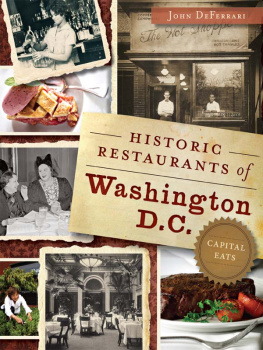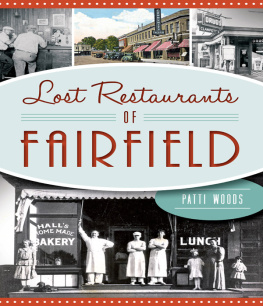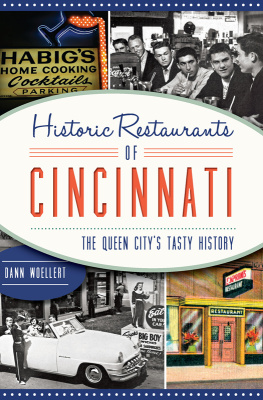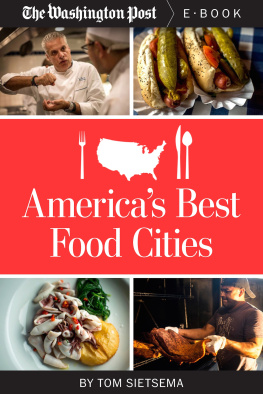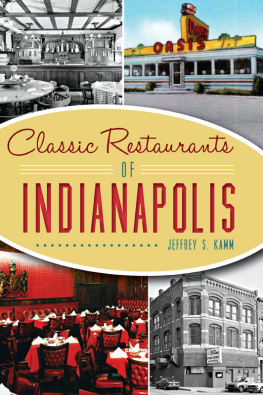
Published by American Palate
A Division of The History Press
Charleston, SC 29403
www.historypress.net
Copyright 2013 by John DeFerrari
All rights reserved
First published 2013
e-book edition 2013
Manufactured in the United States
ISBN 978.1.62584.581.8
Library of Congress CIP data applied for.
print edition ISBN 978.1.62619.126.6
Notice: The information in this book is true and complete to the best of our knowledge. It is offered without guarantee on the part of the author or The History Press. The author and The History Press disclaim all liability in connection with the use of this book.
All rights reserved. No part of this book may be reproduced or transmitted in any form whatsoever without prior written permission from the publisher except in the case of brief quotations embodied in critical articles and reviews.
This book, once again, is for Sue
CONTENTS
PREFACE
If the way to a mans heart is through his stomach, as the old proverb goes, then the way to a citys heart must be through its restaurants. Good restaurants offer both sensory and spiritual delights: good food and good company. The ones you remember are the ones that make you feel at home, the places where you celebrate special occasions and cement relationships, where you propose to someone or are proposed to, where you go when you are down and want to forget your troubles. Beyond whats on your plate, the important thing is the overall experience. The dcor, the ambience, the manners of the wait staff, the owners eccentricities and even the other customers behaviorit all adds up. Looking back over the past two hundred years, it is these qualities that stand out in the citys most notable historic restaurants and make them a unique window into how our local culture has developed and changed.
Conventional wisdom has it that Washingtons meager restaurants, until very recently, were an embarrassment to the city and a sign of its profound cultural shortcomings. But this narrow view considers only the food itself and judges it from the perspective of todays eclectic and demanding customers. In fact, the historical record shows an astonishing diversity of eateries, restaurateurs, chefs and cuisines, and the best places were as loved back then as the finest spots are todayor maybe more so.
In many ways, the development of restaurants in Washington has closely followed developments in New York City, to which our town has so often been compared unfavorably. The first true restaurantsplaces where you could choose when to eat, select items from a menu and be served at a private tableappeared here by the 1830s, not long after they got started in New York. The Swiss-born Delmonico brothers opened one of the first and most famous French restaurants in New York City in about 1830, but only eight years later, John Privaux, a former White House chef, opened a French-style eatery on Pennsylvania Avenue. The banquet at the celebrated Napier Ball, held at the Willard Hotel in 1859, was as grandly excessive as any served at the time in the Big Apple. And while New York in the nineteenth century was famous for its abundant oysters, Washingtons proximity to the Chesapeake Bay gave it an equally endless supply, with oyster houses at one time seemingly on every corner. Even the eccentricities of popular New York eateries found echoes in the nations capital. New Yorks notorious Cobweb Hall, a dark Dickensian haunt hung with thick cobwebs, found an imitator in Andrew Hancocks Old Curiosity Shop on Pennsylvania Avenue, where the famous African American bartender Dick Francis held forth amid a cobwebbed museum of moldering historic artifacts.
Washington restaurants in the mid-nineteenth century offered a bountiful assortment of local delicacies, including terrapin and canvasback duck from the Chesapeake Bay, two emblems of haute cuisine. However, the dawn of the twentieth century brought dramatic changes. Terrapin and canvasbacks became scarce, and extravagant formal dinners fell out of fashion. Lunchrooms and diners began filling the need for cheap food quickly served. The tearoom craze of the 1910s and 1920s brought a whole new genre of charming and informal restaurants that catered primarily to women, while men retreated to clubby steakhouses and traded insults with their hosts. The arrival of Prohibition wiped out a generation of venerable old watering holes and eateries, but new places in tune with the economics of the Depression years took their places. The prolonged food rationing of World War II and subsequent years dampened the restaurant business straight through the 1950s, but in 1960, the election of a new, young president with a taste for fine dining brought resurgence.
The president of the United States, the citys foremost resident, probably has had a more profound influence on the citys eateries than any other single person. Thomas Jefferson, an epicure of the highest order, followed prevailing European fashion by hiring French chef Honor Julien to serve at the White House in 1801. Several later White House chefs, including John Privaux, would follow their Executive Mansion service by opening D.C. restaurants. Any visit by a sitting president to a local restaurant became a notable event; Abraham Lincolns first meal of steamed oysters at Harveys was an occasion the restaurants owners would celebrate for years to come. Almost one hundred years later, John F. Kennedys visits to the Rive Gauche and the fledgling Jockey Club helped ensure their lasting success. George H.W. Bush, Bill Clinton and Barack Obama have likewise boosted the fortunes of a privileged few D.C. restaurants in more recent years.
This book covers two centuries of D.C. history, from 1800 to 2000; my goal was to illustrate the vast changes that have occurred in the restaurant business over two hundred years time, and in doing so Ive had to pick and choose among hundreds of restaurants. This book does not include any recently established places, though there are arguably more good restaurants in Washington now than ever in the past. With a few notable exceptions, it also does not include places that were primarily oriented toward drinking or entertainment. Some people surely will flip through this book looking for a particular haunt and not find it. With apologies to them, I hope the assortment Ive included will offer a wide array of entertaining glimpses into the citys culinary past. Vintage recipes are included primarily for their historical interest and appear as they did in original sources; they have not been professionally tested for this book. Ive also included several intriguing recipes graciously provided by restaurants that are still in business today.
Speaking of graciousness, this book benefited from the help of many people in ways both large and small, including Mohammed Abu-El-Hawa (Mama Ayeshas), Katy Adams and Maureen Hirsch (Clydes Restaurant Group), Nizam Ali (Bens Chili Bowl), Marcellus Arnold, Lawrence Berry, Sallie Buben (Bistro Bis), Reverend Sandra Butler-Truesdale, Evelyn Cuttino, Mel Davis (Michel Richard Citronelle), Patricia DeFerrari, Will Fleishell, Pat Fowler, Martin Garbisu, James Goode, Dont Graves, Bill Holmes, Michael Horsley, Todd Kliman and Denise Wills (Washingtonian magazine), Jeff Krulik, Richard Longstreth, Michele Mount (General Federation of Womens Clubs), Savino Recine (PrimiPiatti), Ruth Simpson Redmond, Bill Rice, Beth Schuster (Marriott International, Inc.), Lindsay Smith (the Palm Restaurant Group), John Valanos (the Monocle) and Felicia Wivchar (U.S. House of Representatives Clerks Office).
In addition, the staff of the Washingtoniana Division of the D.C. Public Library, including Michele Casto, Derek Gray, Mark Greek, Faye Haskins, Jerry McCoy and Jason Moore, provided extensive assistance. Likewise, the staff of the Historical Society of Washington, D.C., including Jennifer Krafchik, Anne McDonough and Anne Rollins, was also indispensible, as were Patsy Fletcher, Kim Williams and Bruce Yarnell of the D.C. Historic Preservation Office.
Next page
